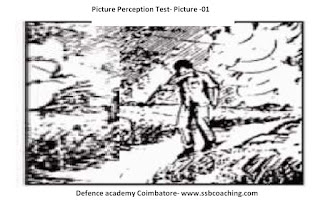Defence Academy Coimbatore
A leading coaching academy for
Sainik, Military and RIMC Schools,
NDA, IMA, AFCAT
SSB, FSB Interview
http://www.ssbcoaching.com
call 094437 20076
Target Get Recommended at SSB/ FSB
Word Association Test- How to write Better?
1.What is Word Assoication Test (WAT)?
Word-association techniques
The list of projective approaches to personality assessment is long, one
of the most venerable being the so-called word-association test. Jung
used associations to groups of related words as a basis for inferring
personality traits (e.g., the inferiority “complex”). Administering a
word-association test is relatively uncomplicated; a list of words is
presented one at a time to the subject who is asked to respond with the
first word or idea that comes to mind. Many of the stimulus words may
appear to be emotionally neutral (e.g., building, first, tree); of
special interest are words that tend to elicit personalized reactions
(e.g., mother, hit, love). The amount of time the subject takes before
beginning each response and the response itself are used in efforts to
analyze a word association test. The idiosyncratic, or unusual, nature
of one’s word-association responses may be gauged by comparing them to
standard published tables of the specific associations given by large
groups of other people.
unconscious wishes, and deep-seated conflicts. Such objective
information is measured by behavioral assessment. It is often used to
identify behavioral problems
Cognitive assessment
The types of thoughts experienced by individuals are reflective of their
personalities. Just as it is important to know what people do and how
their behaviour affects others,
it is also necessary to assess the thoughts that may lie behind the
behaviour. Cognitive assessment provides information about thoughts that
precede, accompany, and follow maladaptive behaviour. It also provides
information about the effects of procedures that are intended to modify
both how subjects think about a problem and how they behave.
The assessment of thoughts and ideas is a relatively new development.
It
has received impetus from the growing evidence that thought processes
and the content of thoughts are related to emotions and behaviour.
Cognitive assessment provides information about adaptive and maladaptive
aspects of people’s thoughts and the role their thoughts play in the
processes of planning, making decisions, and interpreting reality.
This test is also called ‘Confirmatory Test’ to TAT or ‘Idea Writing
Test’. This means that Word Association Test confirms qualities that you
display in Thematic Apperception Test. Giving WAT immediately after the
TAT brings your natural qualities in front of the assessors.
The words shown can be used in any form and tense. Example, ‘die’ can be
used as ‘died’ or ‘dying’.
A total of 60 words is shown for 15 seconds each in which the candidate
has to form a meaningful sentence from it. It is recommended that a
candidate attempts a minimum of 55 words. The test lasts for 15 minutes.
Make your own sentences:
Steer away from sentences that you have memorised or have learnt during
practice. This shows a lack of originality. Instead, try making a link
to the previous sentence as this is more natural and try showing your
OLQ’s through the sentences.
E.g. for the word “Die”, don’t just write “Do or Die is a slogan given
by Gandhiji”. Instead write, “I’m a die-hard cricket fan”. The sentence
is both positive and shows your creative ability.
Make sure you write meaningful and logical sentences. Don’t use your
imaginary power too much while forming sentences in WAT. Make real
sentences and be grounded.
Write grammatically correct sentences and maintain a good handwriting.
This is just something that no one will tell you and no one will bother
telling. But through this,
the assessors test your ability to remain calm and composed under
pressure.
A person struggling to write sentences with bad handwriting and
scribbling answers is more likely not to have the ability to remain calm
and composed under pressure.
Don’t make sentences related to Defence too much. Writing sentences
solely on defence will not take you anywhere. Instead, it shows a lack
of originality and thoughts.
Do not give suggestion or advice to the board or to anyone implicitly through the sentences.
For instance, for the work ‘bring’, don’t write, ‘India should bring
back Dawood Ibrahim’. India knows what to do well, so don’t give advice
to anyone, which takes us to our next point:
Don’t use words like should, could, might, ought, can, may, must, etc.
too much. Again, these form the basis of imaginary sentences.
Keep the sentences to as short as possible. I’d say, sentences having
4-10 words are optimal. Don’t make it too short or too long.
While thinking about a sentence to make from a word, think of the first
image that comes to your mind. This is your original idea of that word.
Now, try to make a positive sentence from that word or relate that
image to a positive story or current affair.
From negative words, try negating the words or having remedial approach.
For example, for the word ‘hate’, try remedial approach as, ‘Love
overcomes the fear hatred’.
In negating this word, you can go, “A mother do not hate her children”.
If, for some words, you are unable to form full sentences, just write your idea about that sentence in a word or two. T
he assessor will understand what you want to convey.
For instance, for the word ‘imagination’, if you couldn’t complete sentence within the given time, just write “good”.
The assessor will understand that you are conveying something about good imagination or are stating that imagination is good.
The last thing about succeeding in WAT is practice a lot with a timer.
Join Defence Academy Coimbatore.
www.ssbcoaching.com
for
14 days ssb /fsb training
Rs. 12,500 with accm
visit
our web site
www.ssbcoaching.com
call 094437 20076


Comments
Post a Comment